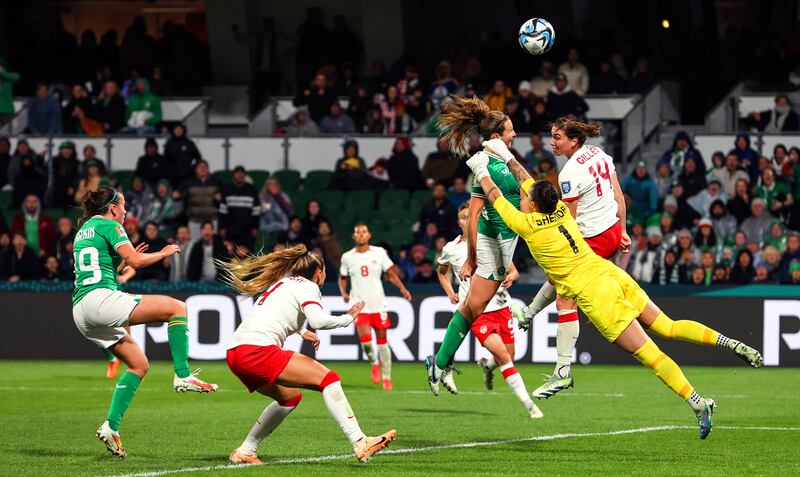These games give you glimpses of what could be and these games tell you to your face what is. Ireland had a first half against Canada like they had a second half against Australia. They played in passages like they belonged, like they had nothing to fear from two of the best teams in the competition. But the hardest thing remains the hardest thing. If you don’t score enough when you’re on top, gravity will usually have its way before long.
Vera Pauw’s side did so much in that first half to deserve better than their ultimate fate. After two campaigns of being rigid and drilled and hard to beat, they had clearly decided not to die wondering. They were pressing high when they didn’t have the ball, they were holding possession in tight areas when they did. They were shaping the ball into Kyra Carusa in a way that finally made the role of Ireland centre forward something more than a thankless treadmill slog.
They were doing, in short, the things you do when you want to be more than just a feelgood story. Nobody in the Ireland squad has a better yarn to tell than Áine O’Gorman. The longest server, the most caps of them all, the only one with a kid at home, five years on from her first retirement. Yet here she was, starting a World Cup match and facing down Jordyn Huitema, 12 years her junior, late of PSG.
O’Gorman wasn’t just digging in and trying to hold out. She was getting on the ball and linking up with Lucy Quinn ahead of her. She was snappy into tackles and kept trying to find Quinn with arced balls down the right touchline. Huitema was having to do a lot of her work going backwards, which can’t have been in the Canadian game plan.
UK football associations preparing joint bid to host 2035 Women’s World Cup
Netflix snaps up US broadcast rights for Women’s World Cup in ‘landmark deal’
Copa 71: ‘These women were gaslit. Imagine playing a sport at the highest level and then being told, that didn’t exist’
Amber Barrett: ‘I say nothing when I don’t know the full truth ... The social media people should have done the same’
This kind of thing was replicated across the pitch. Sinead Farrelly was insinuating herself into the game here and there, all clever flicks and Velcro touch. Lucy Quinn doesn’t have Farrelly’s willowy ability to slide through cracks in the brickwork but she was dogged and insistent both with and without the ball. Ruesha Littlejohn was Ireland’s best player at this stage, breaking up Canadian play like a shushing schoolteacher.
That first half was the kind of Ireland performance everyone has been waiting on for years. The best thing about it was that it wasn’t predicated on Katie McCabe and Denise O’Sullivan doing it by themselves. For so many of the qualifying matches, those two had to keep the engine ticking over and be the ones who showed for balls in tight spaces. That wasn’t the case here.
Though the goal was all down to McCabe’s own brilliance, she was mostly just another cog in the wheel in the first half. O’Sullivan, in fact, was hesitant and out of sorts – maybe because of the yellow card she carried into the game, maybe because of the injury from the Colombia run-out. Whatever the reason, she was having an off-day and Ireland were still bossing the game. That’s where they’ve wanted to get to for so very long and for it to happen at the World Cup against the Olympic champions felt electric.

But everyone knew the terms and conditions too. When Carusa got on a brilliant McCabe pass running into the Canadian box 10 minutes short of the break, you were willing her to cut across the chasing Kadeisha Buchanan. The Canada centre back was having a nightmare on Carusa and already had a yellow card against her name. Any touch now would surely have meant a penalty and a red. Carusa stayed on her feet though and forced a corner. That second goal stayed stubbornly out of reach.
We all know what happened after that. An own goal just before half-time to level it, Canada pushed on to go 2-1 up soon after the break. The favourites made three substitutions to change the game at half-time and another on the hour mark. One of them was Christine Sinclair, eight times shortlisted for world player of the year. Another was Cloé Lacasse, last year’s player of the season in the Portuguese league.
Ireland were always going to need more than one goal to get a point out of a game against a team with that sort of depth. Because when you don’t get the second goal, you leave yourself with no wiggle room. Mistakes take on outsized significance and all those glimpses of what could have been get washed away.
The brass tacks of it are that all three goals Ireland have conceded in Australia have come more or less the same way. A ball in from the left each time, played right-footed under minimal pressure each time, inswinging and landing within a few yards of the Irish penalty spot each time. Not dealt with. Disaster.
Some of that is bad luck. Injuries to Megan Campbell and Aoife Mannion meant that Connolly had to move back from her normal midfield role to the heart of the Ireland defence. Of the eight groups in the tournament, five have either one or none of the world’s top 10 teams in it – Ireland found themselves in one of the ones with two. They put it up to both Australia and Canada but ultimately, they got found out in the same way in both games.
As Katie McCabe said afterwards, they’ve been shown what the level is. The killer is that they weren’t able to make enough of the times when they reached it.














